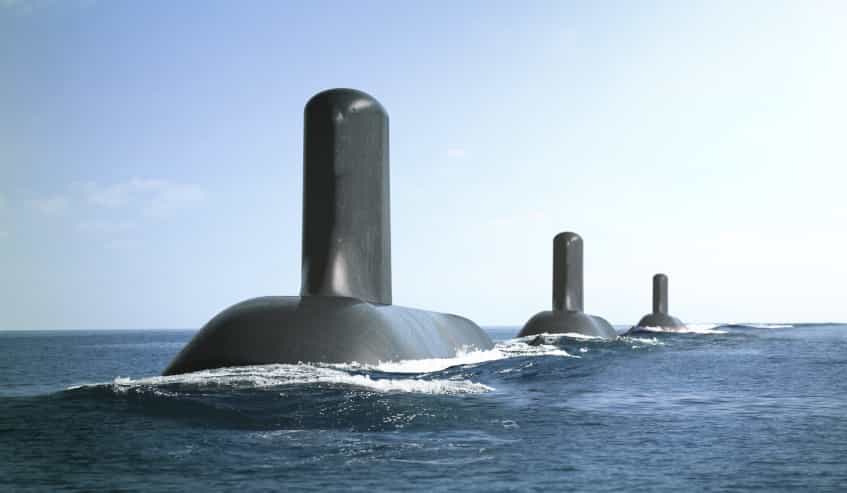Naval Group has signed a subcontract with Schneider Electric France for the design of the main DC switchboard for the Royal Australian Navy’s $50 billion Attack Class submarines.
To continue reading the rest of this article, please log in.
Create free account to get unlimited news articles and more!
The main DC switchboard controls and manages the distribution of power between the submarine’s diesel generators, batteries, main motor and auxiliary power systems.
Design of the switchboard will be undertaken as other aspects of the submarine’s design are developed to ensure capability requirements for the Attack Class are met.
The selection of Schneider Electric France to design the main DC switchboard recognises the company’s significant experience with submarine programs, including Australia’s Collins Class Submarine Program, as reflected in the number of sea-proven technologies it has delivered.
The engagement of Schneider Electric has been undertaken with the objectives of maximising Australian industry involvement in the Attack Class Submarine Program, and ensuring we continue to develop the sovereign capacity to build, operate and sustain our submarines in Australia.
Schneider Electric Australia, which already employs more than 4,000 Australians at seven plants, will play an important role as the capability for manufacturing, quality control and factory acceptance testing is transferred to Australia.
Schneider Electric Australia has a history of supporting Australia’s submarine capability including a service team in Perth dedicated to supporting the Collins submarine fleet. It will also become the design authority for sustainment of the main DC switchboards in the Attack Class submarine fleet.
John Davis, chief executive of Naval Group Australia, welcomed the announcement, saying, "Naval Group is committed to maximising opportunities for Australian industry in all phases of the Future Submarine Program and ensuring we create a sustainable sovereign submarine capability."
In its proposal to Naval Group, Schneider Electric France proposed to build the pre-qualification main DC switchboards for the Attack Class submarine fleet at its facilities in Grenoble, France. All remaining switchboards for the fleet and the Land Based Prototype facility would be built in Australia through its existing Australian subsidiary Schneider Electric Australia.
In doing so, Schneider Electric France plans to:
- Train Schneider Electric Australia engineering and technical management staff during the design and build of the first switchboard, and transfer manufacturing, quality control and factory acceptance testing capabilities to Australia;
- Manage the build and sustainment from the second switchboard onwards in Australia including program management, asset management, product life cycle management, sustainment and integrated logistics support;
- Source the fabrication of the switchboards and heat exchangers, including the production of land-based switchboard prototypes, and non-commercial components, from Australian suppliers; and
- Establish Schneider Electric Australia to act as the design authority for the sustainment (upkeep, upgrade and update) of the subsystem.
The wider Australian industry will also have the opportunity to supply components of the main DC switchboard for the Attack Class Submarine.
Gareth O’Reilly, Australian president of Schneider Electric, said, "Schneider Electric is a recognised global expert in energy management and power systems where safety, reliability and high performance are key. A local Australian project kick-off team has been working closely on this project with colleagues in France for two years and the team will grow to match the project.
"While the contract is directly with Schneider Electric France and they will transfer appropriate capabilities, this project delivers significant work for our local suppliers in manufacturing, fabrication and material supply, based in Adelaide and across Australia."
The Attack Class submarines will be delivered as part of the $50 billion SEA 1000 Future Submarine program. Naval Group will build 12 regionally-superior submarines to the Royal Australian Navy.
Naval Group's successful Shortfin Barracuda design, which serves as the basis for the new Attack Class, is a conventionally-powered variant of the nuclear-powered Barracuda fast attack submarine currently under construction for the French Navy.
Lockheed Martin will provide the AN/BYG-1 Combat control System, which provides an open-architecture submarine combat control system for analysing and tracking submarine and surface-ship contacts, providing situational awareness as well as the capability to target and employ torpedoes and missiles.
The 12 vessels will be built by Naval Group at a specialist submarine shipyard at Osborne, South Australia. The Commonwealth government’s Australian Naval Infrastructure (ANI) program will support the development of the future submarine shipyards.
The Commonwealth government formally signed the strategic partnering agreement (SPA) with Naval Group in February 2019 ahead of confirming the final design specifications and requirements for the Attack Class submarines.
The Attack Class will enter service with the Royal Australian Navy at a time when 50 per cent of the world’s submarines will be operating in the Indo-Pacific region.
Stephen Kuper
Steve has an extensive career across government, defence industry and advocacy, having previously worked for cabinet ministers at both Federal and State levels.

 Login
Login








